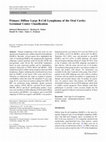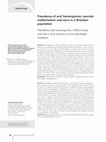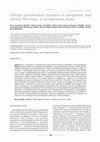Papers by Aline Cristina Batista Rodrigues Johann
ANZ Journal of Surgery, 1999
Malignant peripheral nerve sheath tumour (MPNST) is a rare malignant neoplasm in the maxillofacia... more Malignant peripheral nerve sheath tumour (MPNST) is a rare malignant neoplasm in the maxillofacial region. This study reports on a sporadic case of MPNST located on the tongue and provides a review of existing literature regarding this lesion. Data analyses show four welldocumented cases of MPNST on the tongue.

Head and Neck Pathology, 2010
Primary lymphomas of the oral cavity are rare and the most frequent type is diffuse large B-cell ... more Primary lymphomas of the oral cavity are rare and the most frequent type is diffuse large B-cell lymphoma (DLBCL). Recently, several reports have highlighted the value of classifying DLBCL into prognostically important subgroups, namely germinal center B-cell like (GCB) and non-germinal center B-cell like (non-GCB) lymphomas based on gene expression profiles and by immunohistochemical expression of CD10, BCL6 and MUM-1. GCB lymphomas tend to exhibit a better prognosis than non-GCB lymphomas. Studies validating this classification have been done for DLBCL of the breast, CNS, testes and GI tract. Therefore we undertook this study to examine if primary oral DLBCLs reflect this trend. We identified 13 cases (age range 38-91 years) from our archives dating from 2003-09. IHC was performed using antibodies against germinal center markers (CD10, BCL6), activated B-cell markers (MUM1, BCL2) and Ki-67 (proliferation marker). Cases were sub-classified as GCB subgroup if CD10 and/or BCL6 were positive and MUM-1, was negative and as non-GCB subgroup if CD10 was negative and MUM-1 was positive.

American Journal of Orthodontics and Dentofacial Orthopedics, 2015
Fluoxetine is a widely used antidepressant. Its various effects on bone mineral density are well ... more Fluoxetine is a widely used antidepressant. Its various effects on bone mineral density are well described. The aim of this study was to evaluate the effect of fluoxetine on induced tooth movement. Seventy-two Wistar rats were divided into 3 groups: M (n = 24; 0.9% saline solution and induced tooth movement), FM (n = 24; fluoxetine, 10 mg/kg, and induced tooth movement), and F (n = 24; fluoxetine, 10 mg/kg only). After 30 days of daily saline solution or fluoxetine administration, an orthodontic appliance (30 cN) was used to displace the first molar mesially in groups M and FM. The animals were killed 3, 7, and 14 days after placement of the orthodontic appliances. The animals in group F did not receive induced tooth movement but were killed at the same times. We evaluated tooth movement rates, collagen neoformation rates by polarization microscopy, numbers of osteoclast by tartrate-resistant acid phosphatase, and trabecular bone modeling by microcomputed tomography of the femur. The tooth movement rates were similar in groups M and FM at all studied time points (P >0.05). The rate of newly formed collagen had a reverse pattern in groups M and FM, but the difference was not statistically significant (P >0.05). There were significantly more osteoclasts in group FM than in group F on day 3 (P <0.01). The trabecular spacing was significantly larger in group F compared with group M on day 14 (P <0.05). Fluoxetine did not interfere with induced tooth movement or trabecular bone in rats.
Oral Surgery, Oral Medicine, Oral Pathology, Oral Radiology, and Endodontology, 2009
Brazilian journal of otorhinolaryngology

Brazilian Oral Research, 2007
Hemangioma, vascular malformation and varix are benign vascular lesions, common in the head and n... more Hemangioma, vascular malformation and varix are benign vascular lesions, common in the head and neck regions. Studies about the prevalence of these lesions in the oral cavity are scarce. The aim of this study was to estimate the prevalence of and to obtain clinical data on oral hemangioma, vascular malformation and varix in a Brazilian population. Clinical data on those lesions were retrieved from the clinical forms from the files of the Oral Diagnosis Service, School of Dentistry, Federal University of Minas Gerais, Brazil, from 1992 to 2002. Descriptive analysis was performed. A total of 2,419 clinical forms in the 10-year period were evaluated, of which 154 (6.4%) cases were categorized as oral hemangioma, oral vascular malformation or oral varix. Oral varix was the most frequent lesion (65.6%). Females had more oral hemangioma and oral varix than males. Oral vascular malformation and oral varix were more prevalent in the 7 th and 6 th decades, respectively. Oral hemangioma and oral varix were more prevalent in the ventral surface of the tongue and oral vascular malformation, in the lips. Oral hemangioma was treated with sclerotherapy (54.5%), and vascular malformation was managed with sclerotherapy and surgery (19.4% each). The data of this study suggests that benign vascular lesions are unusual alterations on the oral mucosa and jaws. Descriptors: Hemangioma; Peripheral vascular diseases, epidemiology; Blood vessels, abnormalities; Mouth mucosa.
Oral Health Care - Pediatric, Research, Epidemiology and Clinical Practices, 2012
Oral Surgery, Oral Medicine, Oral Pathology, Oral Radiology, and Endodontology, 2005
Objective. The objective of this study was to report and discuss the results from treatment of be... more Objective. The objective of this study was to report and discuss the results from treatment of benign oral vascular lesions with ethanolamine oleate.
Oral Oncology Extra, 2006
Necrotizing sialometaplasia is an uncommon inflammatory condition that affects salivary glands. A... more Necrotizing sialometaplasia is an uncommon inflammatory condition that affects salivary glands. A 38-year-old man with bilateral ulcerative painful lesions at the junction of the hard and soft palate was presented. An incisional biopsy was performed. Histopathologically, pseudoepithelomatous hyperplasia, lobular necrosis with through the maintenance of the architecture of salivary glands and squamous metaplasia of residual acinar and ductal elements with a bland appearance were observed. The complete self-healing of the lesions occurred in 3 weeks. Since this entity presents clinical and histopathological findings resembling either mucoepidermoid carcinoma or squamous carcinoma diagnostic failure may culminate in unnecessary mutilating surgery.
Journal of Cranio-Maxillofacial Surgery, 2006
Purpose: Osseous choristoma is a rare, benign lesion of the oral cavity and is usually found in t... more Purpose: Osseous choristoma is a rare, benign lesion of the oral cavity and is usually found in the tongue. It presents as a tumour-like mass of normal bony structure with mature cells in an abnormal position. The object of this paper is to report one case of osseous choristoma. Patient: A 32-year-old male presented with a lesion in the submandibular region, which was treated by excision. After 28 months of follow-up there was no recurrence. Conclusion: Upon reviewing the English literature, no previous case of an osseous choristoma located in the submandibular region has been found. Extended clinical and radiographic follow-up is necessary after surgical excision of an osseous choristoma, despite its benign nature. r 2005 European Association for Cranio-Maxillofacial Surgery

Journal of Applied Oral Science, 2013
www.scielo.br/jaos http://dx.5HFHLYHG )HEUXDU\ 0RGL¿FDWLRQ -DQXDU\ $FFHSWHG )HEUXDU\ O bjective: ... more www.scielo.br/jaos http://dx.5HFHLYHG )HEUXDU\ 0RGL¿FDWLRQ -DQXDU\ $FFHSWHG )HEUXDU\ O bjective: To perform a comparative study of the cellular proliferation in the peripheral DQG FHQWUDO ¿EURPDV 0DWHULDO DQG 0HWKRGV ,PPXQRKLVWRFKHPLVWU\ IRU 3&1$ DQG WKH $J125 WHFKQLTXH ZHUH SHUIRUPHG LQ FDVHV RI SHULSKHUDO RGRQWRJHQLF ¿EURPD 32) LQ FDVHV RI RGRQWRJHQLF ¿EURPD 2G) LQ FDVHV RI SHULSKHUDO RVVLI\LQJ ¿EURPD 3(2) DQG FDVHV RI RVVLI\LQJ ¿EURPD 2V) 7KH .UXVNDO:DOOLV DQG 0DQQ:KLWQH\ WHVWV ZHUH used for the statistical analyses. Results: Mesenchymal component of the central lesions presented a higher mean number of AgNOR per nucleus and PCNA index than did the SHULSKHUDO OHVLRQV 3 7KH PHDQ QXPEHU RI $J125 SHU QXFOHXV LQ WKH HSLWKHOLDO FRPSRQHQW SURYHG WR EH KLJKHU LQ WKH 2G) WKDQ LQ WKH 32) 3 7KH PHVHQFK\PDO and epithelial components presented similar mean numbers of AgNOR per nucleus and PCNA index in the OdF, as well as a similar mean number of AgNOR per nucleus in the POF. Conclusions: The mesenchymal component may well play a role in the differences between the biological behaviour of the central lesions as compared to the peripheral lesions. Moreover, considering that the epithelial and mesenchymal components in odontogenic ¿EURPDV SUHVHQWHG D VLPLODU SUROLIHUDWLRQ LQGH[ PRUH UHVHDUFK LV ZDUUDQWHG WR XQGHUVWDQG the true role of the epithelial components, which are believed to be inactive in nature, as well as in the development and biological behaviour of these lesions. Key words: $J125V 2GRQWRJHQLF WXPRXUV 2VVLI\LQJ ¿EURPD 3&1$ 2013;21(2):106-11 &HOOXODU SUROLIHUDWLRQ PDUNHUV LQ SHULSKHUDO DQG FHQWUDO ¿EURPDV D FRPSDUDWLYH VWXG\ 2013;21(2):106-11 J Appl Oral Sci. 108 Table 1-Comparative analysis of data concerning the mean number of AgNOR per nucleus, area and proliferating cellular QXFOHDU DQWLJHQ 3&1$ LQGH[ ,3 LQ WKH PHVHQFK\PDO FRPSRQHQW EHWZHHQ SHULSKHUDO RGRQWRJHQLJ ¿EURPD 32) DQG RGRQWRJHQLF ¿EURPD 2G) DQG SHULSKHUDO RVVLI\LQJ ¿EURPD 3(2) DQG RVVLI\LQJ ¿EURPD 2V)
ANZ Journal of Surgery, 1999
... 6. 4, 24, M, NI, Left, 0.75, Painless, Peripheral, Radical surgery, 2, No metastasis and no r... more ... 6. 4, 24, M, NI, Left, 0.75, Painless, Peripheral, Radical surgery, 2, No metastasis and no recurrence, Yamazaki et al. 12. 5, 37, M, B, Body, 0.25, Painful, Conventional, Radical surgery, 1.5, No metastasis and no recurrence, Fernandes et al. (current case). Full-size table. ...
Oral Surgery Oral Medicine Oral Pathology Oral Radiology and Endodontology, Sep 1, 2009
Uploads
Papers by Aline Cristina Batista Rodrigues Johann